International Business: Expanding BOOTS in India
VerifiedAdded on 2023/06/18
|12
|3982
|400
AI Summary
This report discusses the rationale behind BOOTS expanding internationally to India, the impact of macro factors on the firm's operations, types of barriers the organization would face while expanding internationally, and implementation approaches for the internationalization process.
Contribute Materials
Your contribution can guide someone’s learning journey. Share your
documents today.
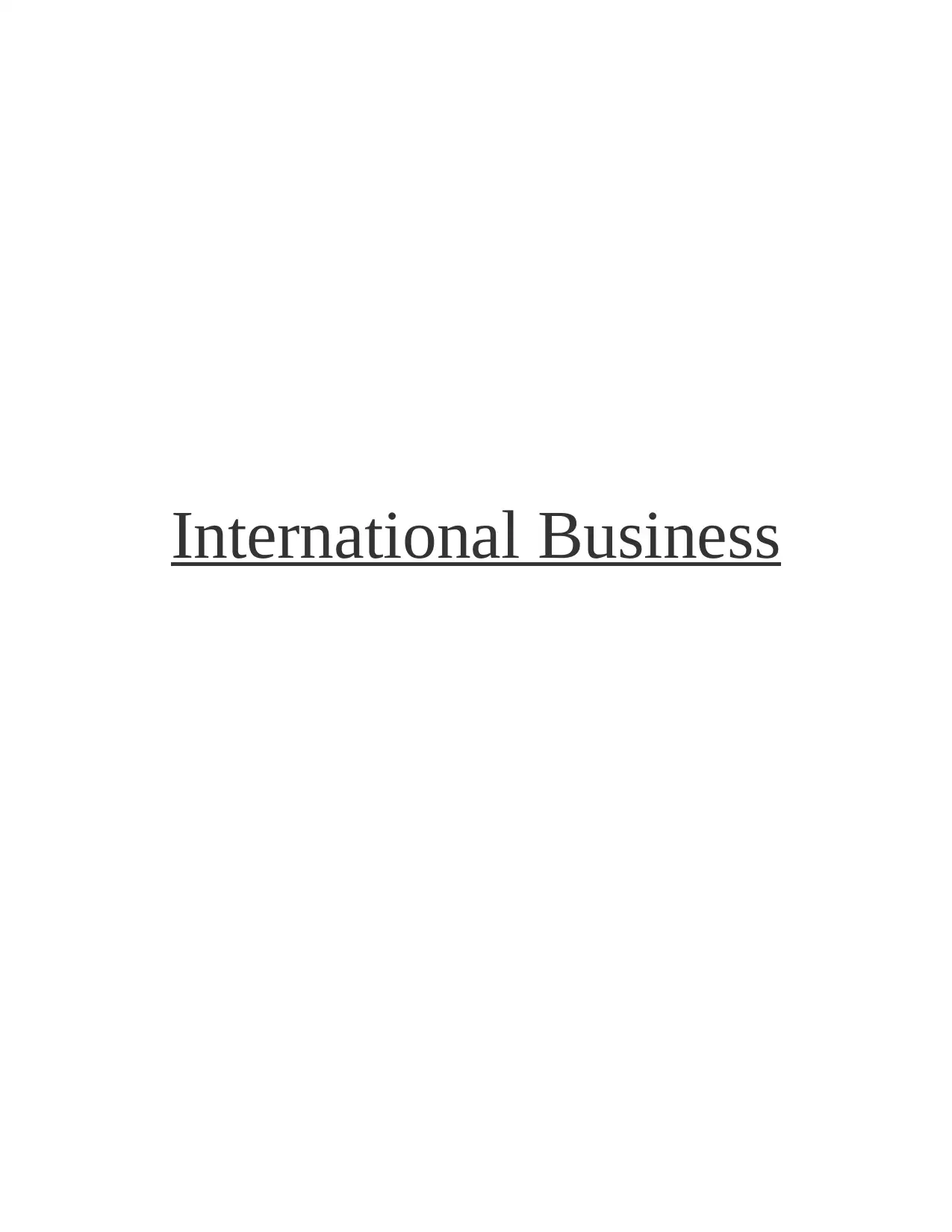
International Business
Secure Best Marks with AI Grader
Need help grading? Try our AI Grader for instant feedback on your assignments.
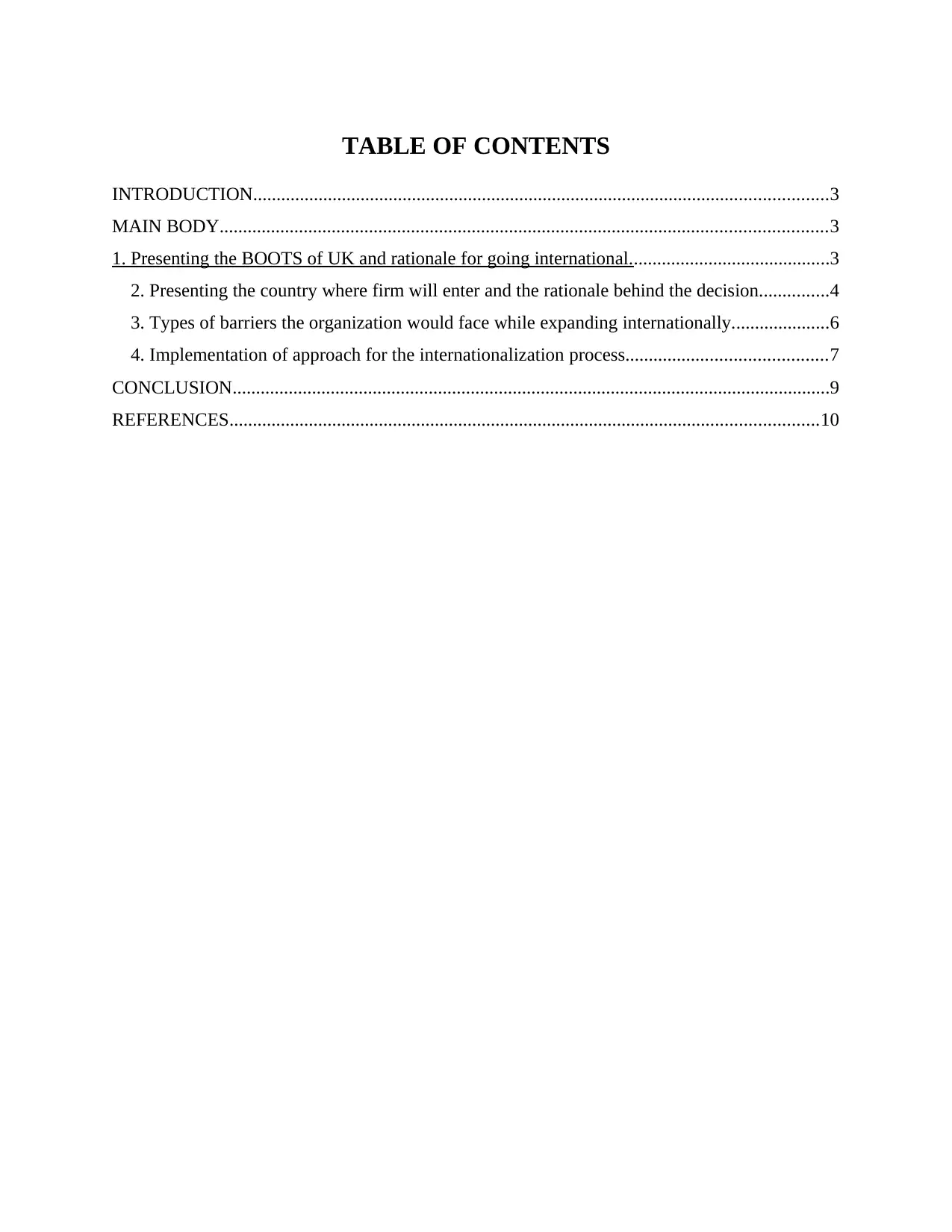
TABLE OF CONTENTS
INTRODUCTION...........................................................................................................................3
MAIN BODY..................................................................................................................................3
1. Presenting the BOOTS of UK and rationale for going international...........................................3
2. Presenting the country where firm will enter and the rationale behind the decision...............4
3. Types of barriers the organization would face while expanding internationally.....................6
4. Implementation of approach for the internationalization process...........................................7
CONCLUSION................................................................................................................................9
REFERENCES..............................................................................................................................10
INTRODUCTION...........................................................................................................................3
MAIN BODY..................................................................................................................................3
1. Presenting the BOOTS of UK and rationale for going international...........................................3
2. Presenting the country where firm will enter and the rationale behind the decision...............4
3. Types of barriers the organization would face while expanding internationally.....................6
4. Implementation of approach for the internationalization process...........................................7
CONCLUSION................................................................................................................................9
REFERENCES..............................................................................................................................10
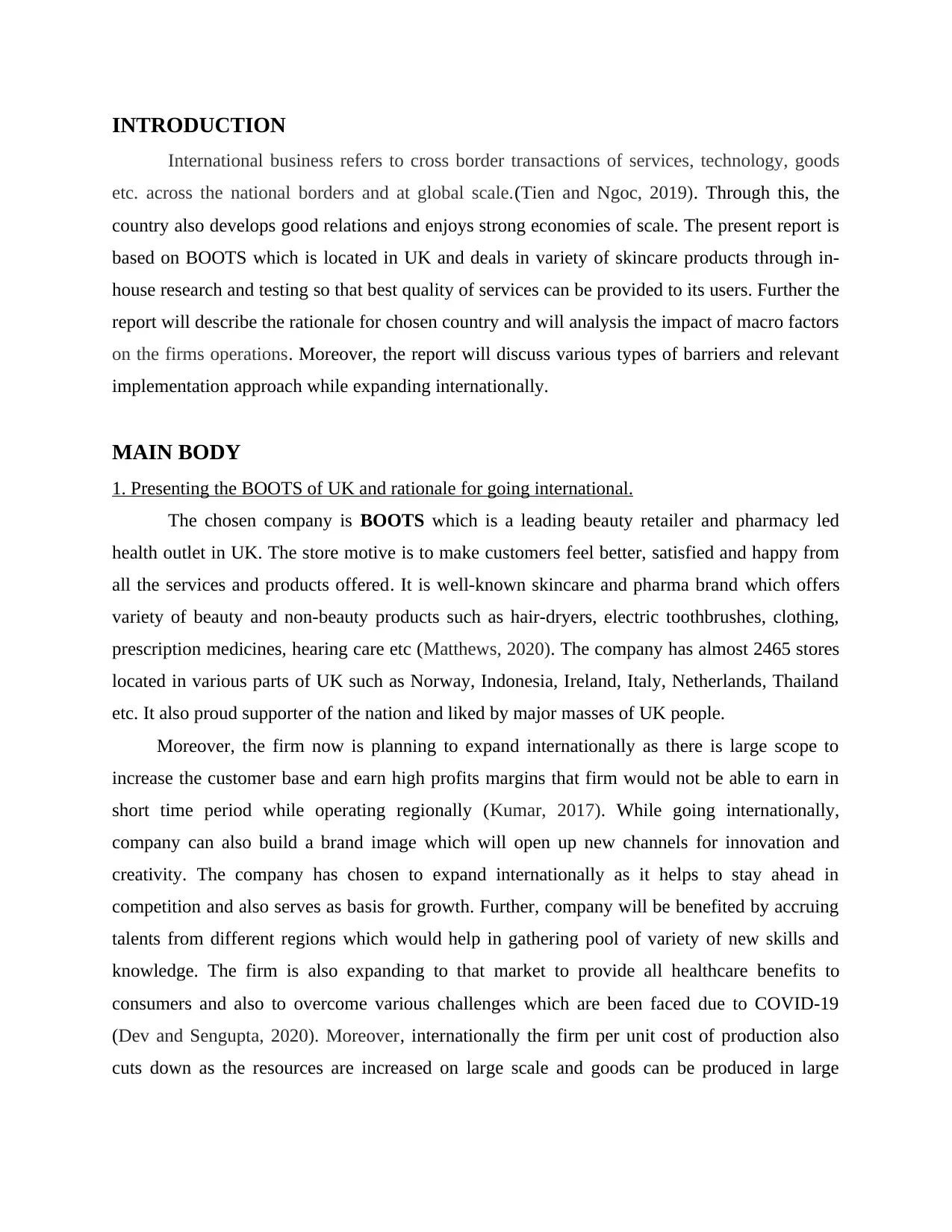
INTRODUCTION
International business refers to cross border transactions of services, technology, goods
etc. across the national borders and at global scale.(Tien and Ngoc, 2019). Through this, the
country also develops good relations and enjoys strong economies of scale. The present report is
based on BOOTS which is located in UK and deals in variety of skincare products through in-
house research and testing so that best quality of services can be provided to its users. Further the
report will describe the rationale for chosen country and will analysis the impact of macro factors
on the firms operations. Moreover, the report will discuss various types of barriers and relevant
implementation approach while expanding internationally.
MAIN BODY
1. Presenting the BOOTS of UK and rationale for going international.
The chosen company is BOOTS which is a leading beauty retailer and pharmacy led
health outlet in UK. The store motive is to make customers feel better, satisfied and happy from
all the services and products offered. It is well-known skincare and pharma brand which offers
variety of beauty and non-beauty products such as hair-dryers, electric toothbrushes, clothing,
prescription medicines, hearing care etc (Matthews, 2020). The company has almost 2465 stores
located in various parts of UK such as Norway, Indonesia, Ireland, Italy, Netherlands, Thailand
etc. It also proud supporter of the nation and liked by major masses of UK people.
Moreover, the firm now is planning to expand internationally as there is large scope to
increase the customer base and earn high profits margins that firm would not be able to earn in
short time period while operating regionally (Kumar, 2017). While going internationally,
company can also build a brand image which will open up new channels for innovation and
creativity. The company has chosen to expand internationally as it helps to stay ahead in
competition and also serves as basis for growth. Further, company will be benefited by accruing
talents from different regions which would help in gathering pool of variety of new skills and
knowledge. The firm is also expanding to that market to provide all healthcare benefits to
consumers and also to overcome various challenges which are been faced due to COVID-19
(Dev and Sengupta, 2020). Moreover, internationally the firm per unit cost of production also
cuts down as the resources are increased on large scale and goods can be produced in large
International business refers to cross border transactions of services, technology, goods
etc. across the national borders and at global scale.(Tien and Ngoc, 2019). Through this, the
country also develops good relations and enjoys strong economies of scale. The present report is
based on BOOTS which is located in UK and deals in variety of skincare products through in-
house research and testing so that best quality of services can be provided to its users. Further the
report will describe the rationale for chosen country and will analysis the impact of macro factors
on the firms operations. Moreover, the report will discuss various types of barriers and relevant
implementation approach while expanding internationally.
MAIN BODY
1. Presenting the BOOTS of UK and rationale for going international.
The chosen company is BOOTS which is a leading beauty retailer and pharmacy led
health outlet in UK. The store motive is to make customers feel better, satisfied and happy from
all the services and products offered. It is well-known skincare and pharma brand which offers
variety of beauty and non-beauty products such as hair-dryers, electric toothbrushes, clothing,
prescription medicines, hearing care etc (Matthews, 2020). The company has almost 2465 stores
located in various parts of UK such as Norway, Indonesia, Ireland, Italy, Netherlands, Thailand
etc. It also proud supporter of the nation and liked by major masses of UK people.
Moreover, the firm now is planning to expand internationally as there is large scope to
increase the customer base and earn high profits margins that firm would not be able to earn in
short time period while operating regionally (Kumar, 2017). While going internationally,
company can also build a brand image which will open up new channels for innovation and
creativity. The company has chosen to expand internationally as it helps to stay ahead in
competition and also serves as basis for growth. Further, company will be benefited by accruing
talents from different regions which would help in gathering pool of variety of new skills and
knowledge. The firm is also expanding to that market to provide all healthcare benefits to
consumers and also to overcome various challenges which are been faced due to COVID-19
(Dev and Sengupta, 2020). Moreover, internationally the firm per unit cost of production also
cuts down as the resources are increased on large scale and goods can be produced in large
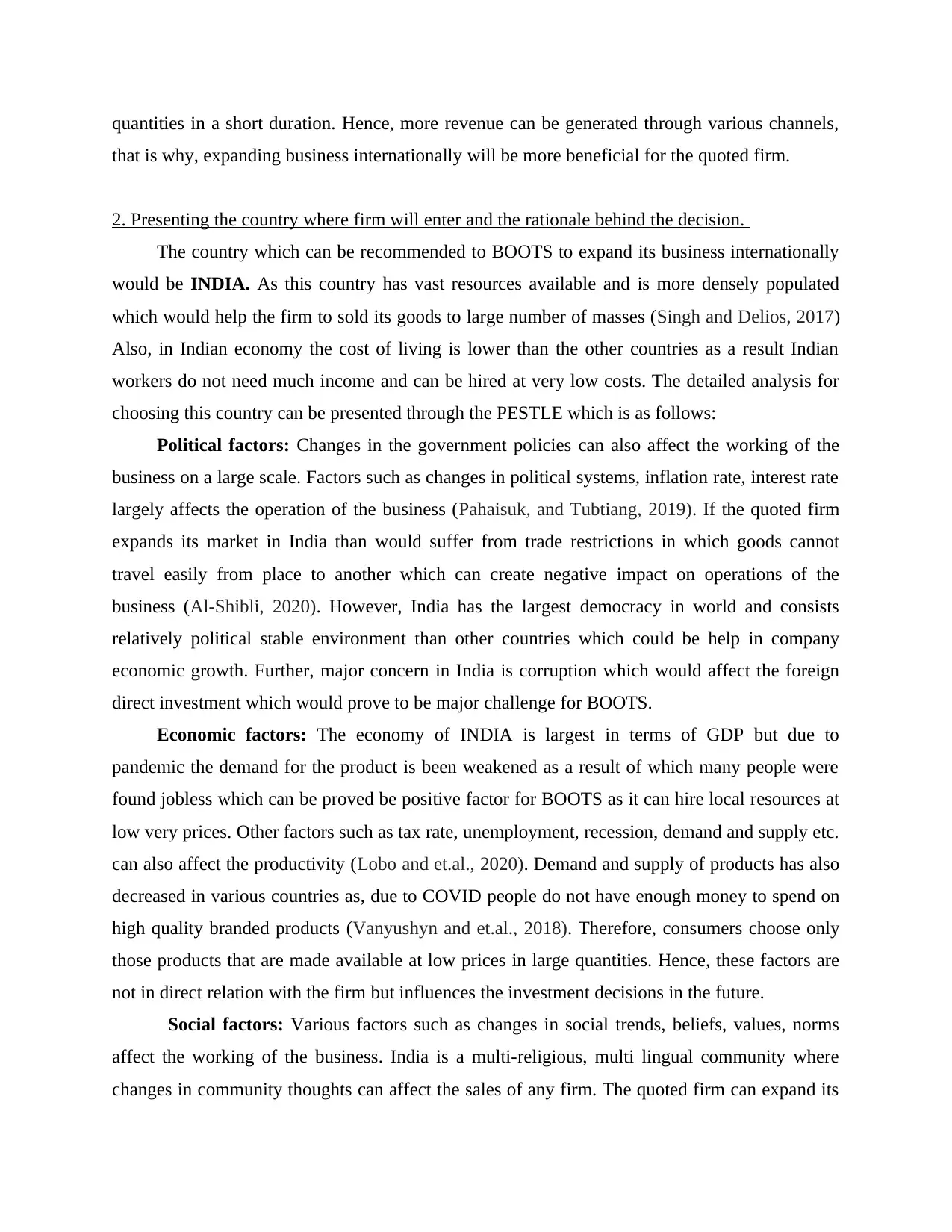
quantities in a short duration. Hence, more revenue can be generated through various channels,
that is why, expanding business internationally will be more beneficial for the quoted firm.
2. Presenting the country where firm will enter and the rationale behind the decision.
The country which can be recommended to BOOTS to expand its business internationally
would be INDIA. As this country has vast resources available and is more densely populated
which would help the firm to sold its goods to large number of masses (Singh and Delios, 2017)
Also, in Indian economy the cost of living is lower than the other countries as a result Indian
workers do not need much income and can be hired at very low costs. The detailed analysis for
choosing this country can be presented through the PESTLE which is as follows:
Political factors: Changes in the government policies can also affect the working of the
business on a large scale. Factors such as changes in political systems, inflation rate, interest rate
largely affects the operation of the business (Pahaisuk, and Tubtiang, 2019). If the quoted firm
expands its market in India than would suffer from trade restrictions in which goods cannot
travel easily from place to another which can create negative impact on operations of the
business (Al-Shibli, 2020). However, India has the largest democracy in world and consists
relatively political stable environment than other countries which could be help in company
economic growth. Further, major concern in India is corruption which would affect the foreign
direct investment which would prove to be major challenge for BOOTS.
Economic factors: The economy of INDIA is largest in terms of GDP but due to
pandemic the demand for the product is been weakened as a result of which many people were
found jobless which can be proved be positive factor for BOOTS as it can hire local resources at
low very prices. Other factors such as tax rate, unemployment, recession, demand and supply etc.
can also affect the productivity (Lobo and et.al., 2020). Demand and supply of products has also
decreased in various countries as, due to COVID people do not have enough money to spend on
high quality branded products (Vanyushyn and et.al., 2018). Therefore, consumers choose only
those products that are made available at low prices in large quantities. Hence, these factors are
not in direct relation with the firm but influences the investment decisions in the future.
Social factors: Various factors such as changes in social trends, beliefs, values, norms
affect the working of the business. India is a multi-religious, multi lingual community where
changes in community thoughts can affect the sales of any firm. The quoted firm can expand its
that is why, expanding business internationally will be more beneficial for the quoted firm.
2. Presenting the country where firm will enter and the rationale behind the decision.
The country which can be recommended to BOOTS to expand its business internationally
would be INDIA. As this country has vast resources available and is more densely populated
which would help the firm to sold its goods to large number of masses (Singh and Delios, 2017)
Also, in Indian economy the cost of living is lower than the other countries as a result Indian
workers do not need much income and can be hired at very low costs. The detailed analysis for
choosing this country can be presented through the PESTLE which is as follows:
Political factors: Changes in the government policies can also affect the working of the
business on a large scale. Factors such as changes in political systems, inflation rate, interest rate
largely affects the operation of the business (Pahaisuk, and Tubtiang, 2019). If the quoted firm
expands its market in India than would suffer from trade restrictions in which goods cannot
travel easily from place to another which can create negative impact on operations of the
business (Al-Shibli, 2020). However, India has the largest democracy in world and consists
relatively political stable environment than other countries which could be help in company
economic growth. Further, major concern in India is corruption which would affect the foreign
direct investment which would prove to be major challenge for BOOTS.
Economic factors: The economy of INDIA is largest in terms of GDP but due to
pandemic the demand for the product is been weakened as a result of which many people were
found jobless which can be proved be positive factor for BOOTS as it can hire local resources at
low very prices. Other factors such as tax rate, unemployment, recession, demand and supply etc.
can also affect the productivity (Lobo and et.al., 2020). Demand and supply of products has also
decreased in various countries as, due to COVID people do not have enough money to spend on
high quality branded products (Vanyushyn and et.al., 2018). Therefore, consumers choose only
those products that are made available at low prices in large quantities. Hence, these factors are
not in direct relation with the firm but influences the investment decisions in the future.
Social factors: Various factors such as changes in social trends, beliefs, values, norms
affect the working of the business. India is a multi-religious, multi lingual community where
changes in community thoughts can affect the sales of any firm. The quoted firm can expand its
Paraphrase This Document
Need a fresh take? Get an instant paraphrase of this document with our AI Paraphraser

market in India when it keeps in mind the current choices and preferences of the customer
(Tiwari, Bhat and Tikoria, 2017). As customers would be ready to pay a little higher for those
products which are not easily available in local market. Also, social factor can proved to be
positive for the quoted firm as large number of people in India fall under the age group of 18-35
and are working class, so they would ready to buy the foreign beauty products of premium
quality.
Technological factors: Today modern era is of technological environment and INDIA
has large number of highly skilled workforce which can help quoted firm to generate better ideas
using various software development techniques which will ultimately upgrade the current
working style of BOOTS (Pagani, and Pardo, 2017). Also, with the development of online
mobile apps and business solutions provided by agencies there is greater ease in the business. As
a result, the quoted firm can ensure faster delivery of products and services in all parts of the
India with just one click. Also, with installation of heavy machines at the workplace by the
quoted firm can reduce the cost of production on a large scale (The advantages and
disadvantages of international expansions, 2019).
Legal factors: Various labour laws, legislations, government control, unfair competition
and many other factors becomes a source of hindrance when company is expanded globally. But
India is a country where all the laws are systematically made so that protection and rights of the
citizens can be ensured (Phan, 2021). Further, because of global pandemic the BOOTS will be
benefited in India through government support as administration is ready to accept offers that
will create job opportunities and generate income for all the jobless people. Further only demerit
the firm will face is that Indian laws are made in such manner that quoted firm cannot change the
prices of the products without prior information given to the customers.
Environmental factors: Factors such as climate, pollution, weather etc. also affect the
working of the business. India has variety of seasons and some parts of India have favourable
climatic conditions for the operations of the quoted firm. This way the supply chain will not be
affected and company can use recycle plastic to manufacture its products to avoid minimum
environmental pollution which is a major concern today for Indian people (Min, Joo, and Choi,
2021). Further, India is rich in natural resources, which will prove as an additional benefit for
quoted firm as line of production would not be affected due to continuous supply.
(Tiwari, Bhat and Tikoria, 2017). As customers would be ready to pay a little higher for those
products which are not easily available in local market. Also, social factor can proved to be
positive for the quoted firm as large number of people in India fall under the age group of 18-35
and are working class, so they would ready to buy the foreign beauty products of premium
quality.
Technological factors: Today modern era is of technological environment and INDIA
has large number of highly skilled workforce which can help quoted firm to generate better ideas
using various software development techniques which will ultimately upgrade the current
working style of BOOTS (Pagani, and Pardo, 2017). Also, with the development of online
mobile apps and business solutions provided by agencies there is greater ease in the business. As
a result, the quoted firm can ensure faster delivery of products and services in all parts of the
India with just one click. Also, with installation of heavy machines at the workplace by the
quoted firm can reduce the cost of production on a large scale (The advantages and
disadvantages of international expansions, 2019).
Legal factors: Various labour laws, legislations, government control, unfair competition
and many other factors becomes a source of hindrance when company is expanded globally. But
India is a country where all the laws are systematically made so that protection and rights of the
citizens can be ensured (Phan, 2021). Further, because of global pandemic the BOOTS will be
benefited in India through government support as administration is ready to accept offers that
will create job opportunities and generate income for all the jobless people. Further only demerit
the firm will face is that Indian laws are made in such manner that quoted firm cannot change the
prices of the products without prior information given to the customers.
Environmental factors: Factors such as climate, pollution, weather etc. also affect the
working of the business. India has variety of seasons and some parts of India have favourable
climatic conditions for the operations of the quoted firm. This way the supply chain will not be
affected and company can use recycle plastic to manufacture its products to avoid minimum
environmental pollution which is a major concern today for Indian people (Min, Joo, and Choi,
2021). Further, India is rich in natural resources, which will prove as an additional benefit for
quoted firm as line of production would not be affected due to continuous supply.
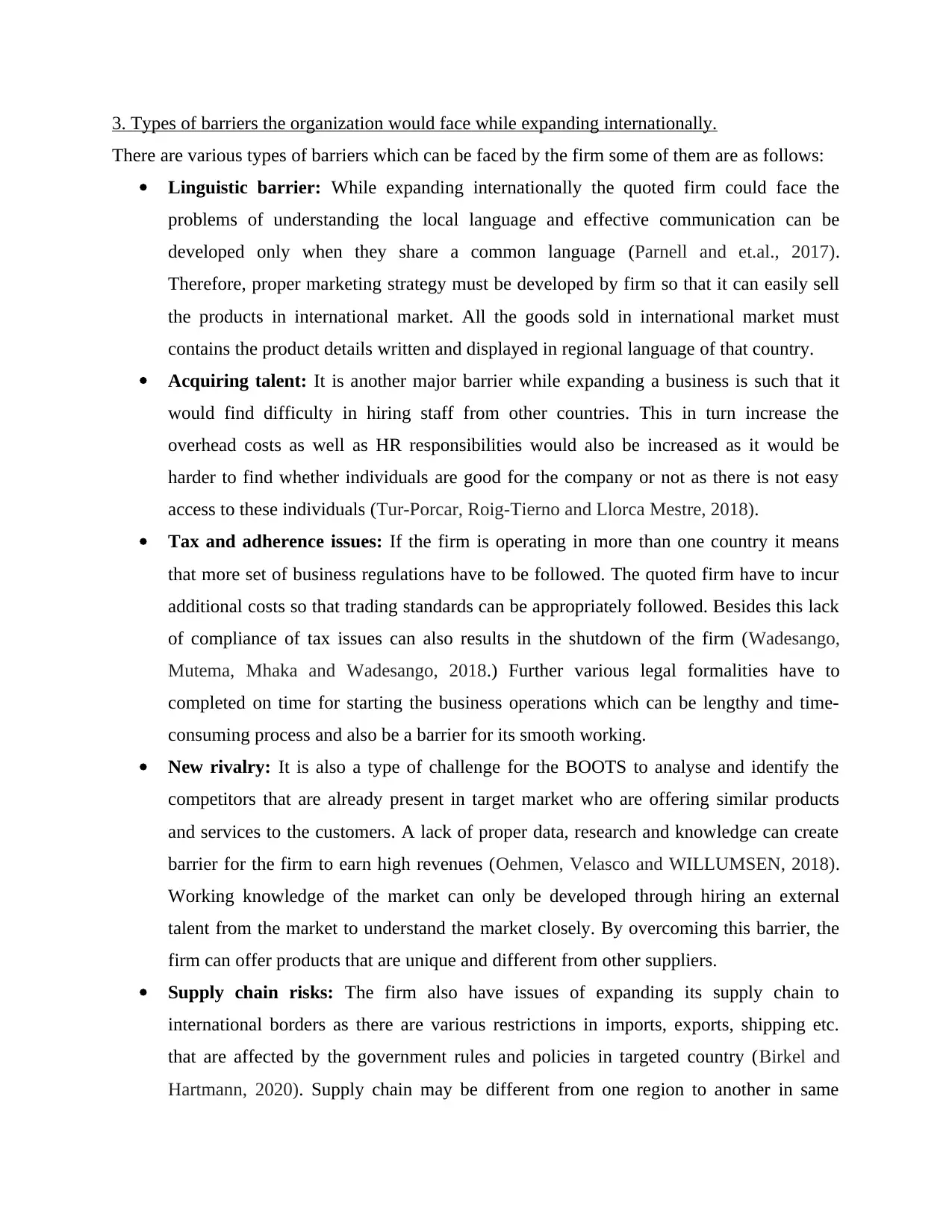
3. Types of barriers the organization would face while expanding internationally.
There are various types of barriers which can be faced by the firm some of them are as follows:
Linguistic barrier: While expanding internationally the quoted firm could face the
problems of understanding the local language and effective communication can be
developed only when they share a common language (Parnell and et.al., 2017).
Therefore, proper marketing strategy must be developed by firm so that it can easily sell
the products in international market. All the goods sold in international market must
contains the product details written and displayed in regional language of that country.
Acquiring talent: It is another major barrier while expanding a business is such that it
would find difficulty in hiring staff from other countries. This in turn increase the
overhead costs as well as HR responsibilities would also be increased as it would be
harder to find whether individuals are good for the company or not as there is not easy
access to these individuals (Tur-Porcar, Roig-Tierno and Llorca Mestre, 2018).
Tax and adherence issues: If the firm is operating in more than one country it means
that more set of business regulations have to be followed. The quoted firm have to incur
additional costs so that trading standards can be appropriately followed. Besides this lack
of compliance of tax issues can also results in the shutdown of the firm (Wadesango,
Mutema, Mhaka and Wadesango, 2018.) Further various legal formalities have to
completed on time for starting the business operations which can be lengthy and time-
consuming process and also be a barrier for its smooth working.
New rivalry: It is also a type of challenge for the BOOTS to analyse and identify the
competitors that are already present in target market who are offering similar products
and services to the customers. A lack of proper data, research and knowledge can create
barrier for the firm to earn high revenues (Oehmen, Velasco and WILLUMSEN, 2018).
Working knowledge of the market can only be developed through hiring an external
talent from the market to understand the market closely. By overcoming this barrier, the
firm can offer products that are unique and different from other suppliers.
Supply chain risks: The firm also have issues of expanding its supply chain to
international borders as there are various restrictions in imports, exports, shipping etc.
that are affected by the government rules and policies in targeted country (Birkel and
Hartmann, 2020). Supply chain may be different from one region to another in same
There are various types of barriers which can be faced by the firm some of them are as follows:
Linguistic barrier: While expanding internationally the quoted firm could face the
problems of understanding the local language and effective communication can be
developed only when they share a common language (Parnell and et.al., 2017).
Therefore, proper marketing strategy must be developed by firm so that it can easily sell
the products in international market. All the goods sold in international market must
contains the product details written and displayed in regional language of that country.
Acquiring talent: It is another major barrier while expanding a business is such that it
would find difficulty in hiring staff from other countries. This in turn increase the
overhead costs as well as HR responsibilities would also be increased as it would be
harder to find whether individuals are good for the company or not as there is not easy
access to these individuals (Tur-Porcar, Roig-Tierno and Llorca Mestre, 2018).
Tax and adherence issues: If the firm is operating in more than one country it means
that more set of business regulations have to be followed. The quoted firm have to incur
additional costs so that trading standards can be appropriately followed. Besides this lack
of compliance of tax issues can also results in the shutdown of the firm (Wadesango,
Mutema, Mhaka and Wadesango, 2018.) Further various legal formalities have to
completed on time for starting the business operations which can be lengthy and time-
consuming process and also be a barrier for its smooth working.
New rivalry: It is also a type of challenge for the BOOTS to analyse and identify the
competitors that are already present in target market who are offering similar products
and services to the customers. A lack of proper data, research and knowledge can create
barrier for the firm to earn high revenues (Oehmen, Velasco and WILLUMSEN, 2018).
Working knowledge of the market can only be developed through hiring an external
talent from the market to understand the market closely. By overcoming this barrier, the
firm can offer products that are unique and different from other suppliers.
Supply chain risks: The firm also have issues of expanding its supply chain to
international borders as there are various restrictions in imports, exports, shipping etc.
that are affected by the government rules and policies in targeted country (Birkel and
Hartmann, 2020). Supply chain may be different from one region to another in same
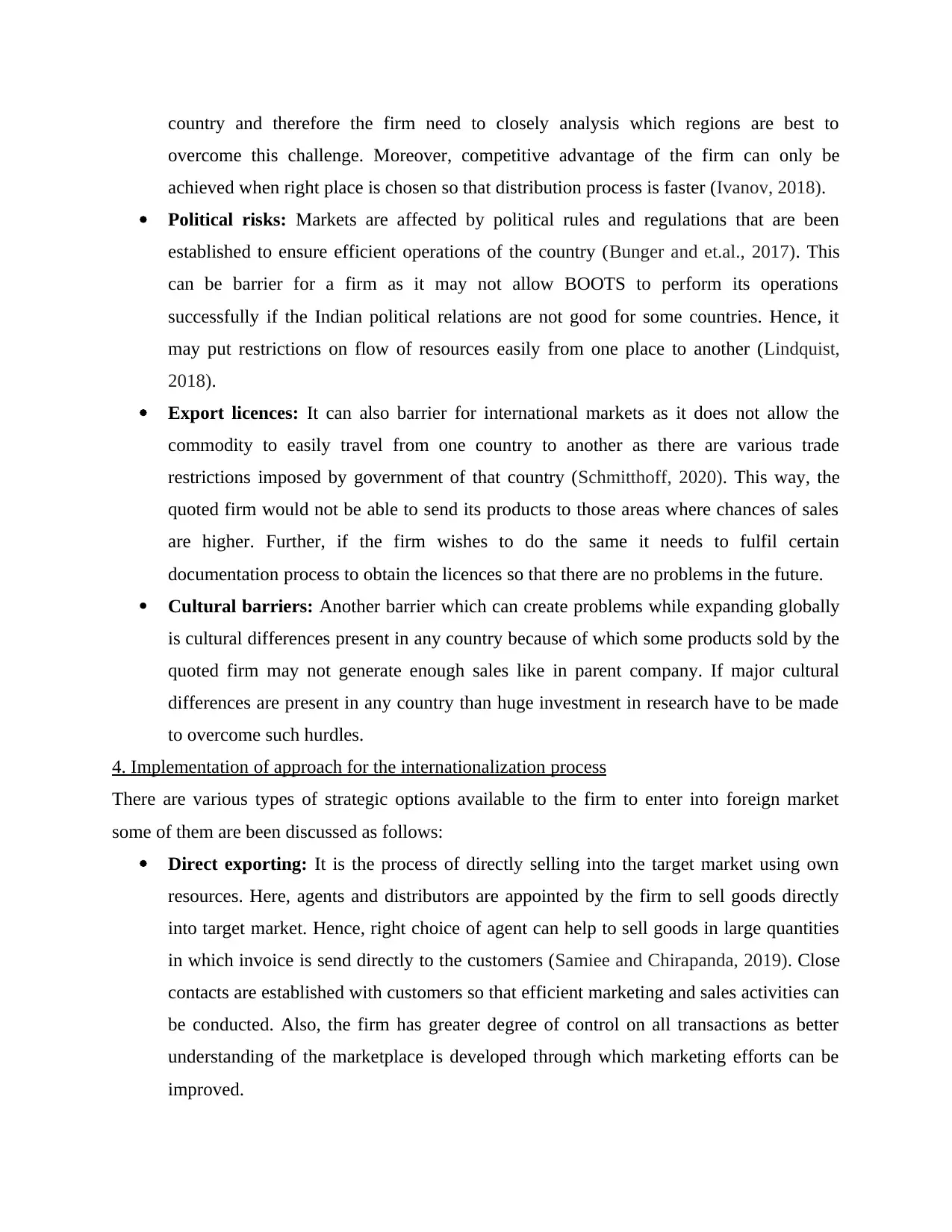
country and therefore the firm need to closely analysis which regions are best to
overcome this challenge. Moreover, competitive advantage of the firm can only be
achieved when right place is chosen so that distribution process is faster (Ivanov, 2018).
Political risks: Markets are affected by political rules and regulations that are been
established to ensure efficient operations of the country (Bunger and et.al., 2017). This
can be barrier for a firm as it may not allow BOOTS to perform its operations
successfully if the Indian political relations are not good for some countries. Hence, it
may put restrictions on flow of resources easily from one place to another (Lindquist,
2018).
Export licences: It can also barrier for international markets as it does not allow the
commodity to easily travel from one country to another as there are various trade
restrictions imposed by government of that country (Schmitthoff, 2020). This way, the
quoted firm would not be able to send its products to those areas where chances of sales
are higher. Further, if the firm wishes to do the same it needs to fulfil certain
documentation process to obtain the licences so that there are no problems in the future.
Cultural barriers: Another barrier which can create problems while expanding globally
is cultural differences present in any country because of which some products sold by the
quoted firm may not generate enough sales like in parent company. If major cultural
differences are present in any country than huge investment in research have to be made
to overcome such hurdles.
4. Implementation of approach for the internationalization process
There are various types of strategic options available to the firm to enter into foreign market
some of them are been discussed as follows:
Direct exporting: It is the process of directly selling into the target market using own
resources. Here, agents and distributors are appointed by the firm to sell goods directly
into target market. Hence, right choice of agent can help to sell goods in large quantities
in which invoice is send directly to the customers (Samiee and Chirapanda, 2019). Close
contacts are established with customers so that efficient marketing and sales activities can
be conducted. Also, the firm has greater degree of control on all transactions as better
understanding of the marketplace is developed through which marketing efforts can be
improved.
overcome this challenge. Moreover, competitive advantage of the firm can only be
achieved when right place is chosen so that distribution process is faster (Ivanov, 2018).
Political risks: Markets are affected by political rules and regulations that are been
established to ensure efficient operations of the country (Bunger and et.al., 2017). This
can be barrier for a firm as it may not allow BOOTS to perform its operations
successfully if the Indian political relations are not good for some countries. Hence, it
may put restrictions on flow of resources easily from one place to another (Lindquist,
2018).
Export licences: It can also barrier for international markets as it does not allow the
commodity to easily travel from one country to another as there are various trade
restrictions imposed by government of that country (Schmitthoff, 2020). This way, the
quoted firm would not be able to send its products to those areas where chances of sales
are higher. Further, if the firm wishes to do the same it needs to fulfil certain
documentation process to obtain the licences so that there are no problems in the future.
Cultural barriers: Another barrier which can create problems while expanding globally
is cultural differences present in any country because of which some products sold by the
quoted firm may not generate enough sales like in parent company. If major cultural
differences are present in any country than huge investment in research have to be made
to overcome such hurdles.
4. Implementation of approach for the internationalization process
There are various types of strategic options available to the firm to enter into foreign market
some of them are been discussed as follows:
Direct exporting: It is the process of directly selling into the target market using own
resources. Here, agents and distributors are appointed by the firm to sell goods directly
into target market. Hence, right choice of agent can help to sell goods in large quantities
in which invoice is send directly to the customers (Samiee and Chirapanda, 2019). Close
contacts are established with customers so that efficient marketing and sales activities can
be conducted. Also, the firm has greater degree of control on all transactions as better
understanding of the marketplace is developed through which marketing efforts can be
improved.
Secure Best Marks with AI Grader
Need help grading? Try our AI Grader for instant feedback on your assignments.
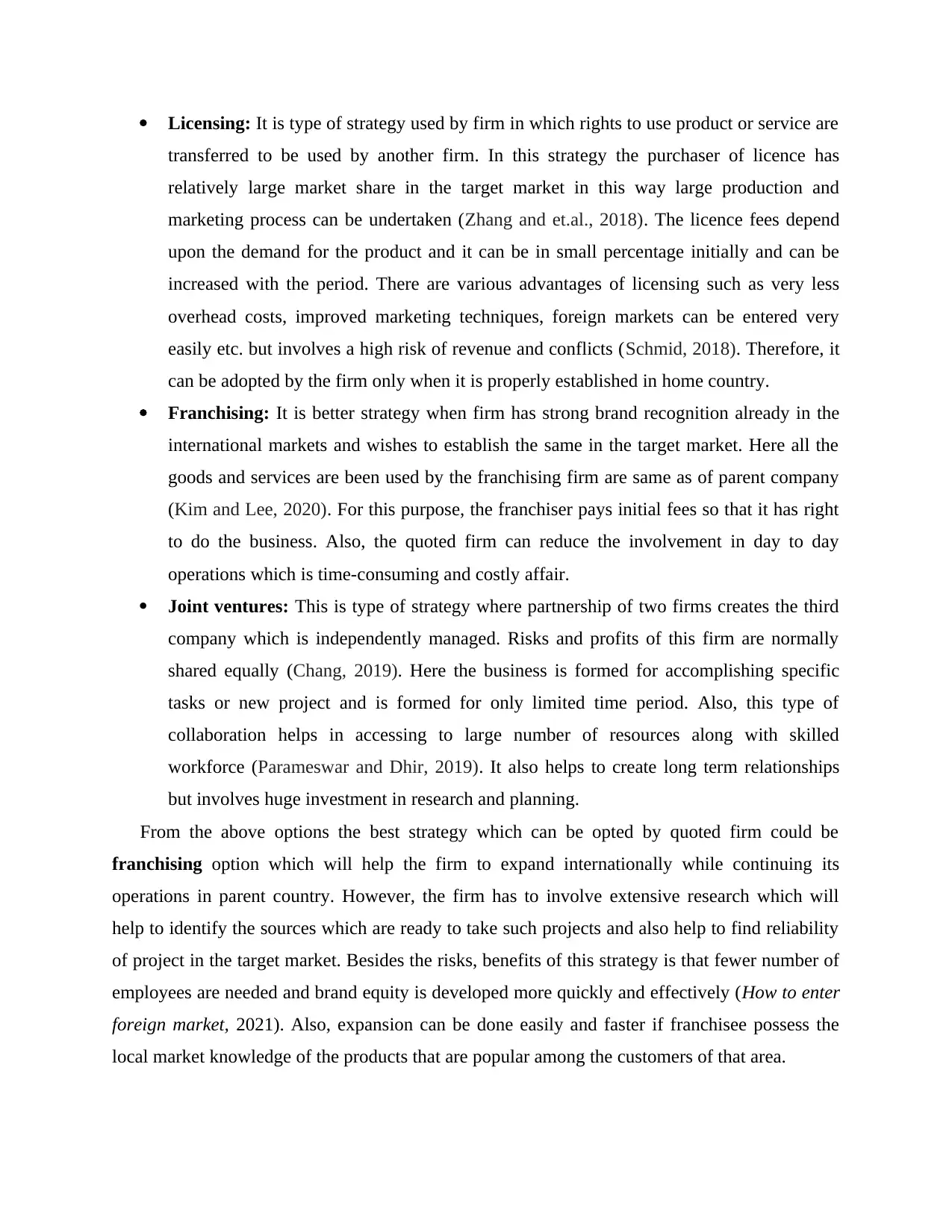
Licensing: It is type of strategy used by firm in which rights to use product or service are
transferred to be used by another firm. In this strategy the purchaser of licence has
relatively large market share in the target market in this way large production and
marketing process can be undertaken (Zhang and et.al., 2018). The licence fees depend
upon the demand for the product and it can be in small percentage initially and can be
increased with the period. There are various advantages of licensing such as very less
overhead costs, improved marketing techniques, foreign markets can be entered very
easily etc. but involves a high risk of revenue and conflicts (Schmid, 2018). Therefore, it
can be adopted by the firm only when it is properly established in home country.
Franchising: It is better strategy when firm has strong brand recognition already in the
international markets and wishes to establish the same in the target market. Here all the
goods and services are been used by the franchising firm are same as of parent company
(Kim and Lee, 2020). For this purpose, the franchiser pays initial fees so that it has right
to do the business. Also, the quoted firm can reduce the involvement in day to day
operations which is time-consuming and costly affair.
Joint ventures: This is type of strategy where partnership of two firms creates the third
company which is independently managed. Risks and profits of this firm are normally
shared equally (Chang, 2019). Here the business is formed for accomplishing specific
tasks or new project and is formed for only limited time period. Also, this type of
collaboration helps in accessing to large number of resources along with skilled
workforce (Parameswar and Dhir, 2019). It also helps to create long term relationships
but involves huge investment in research and planning.
From the above options the best strategy which can be opted by quoted firm could be
franchising option which will help the firm to expand internationally while continuing its
operations in parent country. However, the firm has to involve extensive research which will
help to identify the sources which are ready to take such projects and also help to find reliability
of project in the target market. Besides the risks, benefits of this strategy is that fewer number of
employees are needed and brand equity is developed more quickly and effectively (How to enter
foreign market, 2021). Also, expansion can be done easily and faster if franchisee possess the
local market knowledge of the products that are popular among the customers of that area.
transferred to be used by another firm. In this strategy the purchaser of licence has
relatively large market share in the target market in this way large production and
marketing process can be undertaken (Zhang and et.al., 2018). The licence fees depend
upon the demand for the product and it can be in small percentage initially and can be
increased with the period. There are various advantages of licensing such as very less
overhead costs, improved marketing techniques, foreign markets can be entered very
easily etc. but involves a high risk of revenue and conflicts (Schmid, 2018). Therefore, it
can be adopted by the firm only when it is properly established in home country.
Franchising: It is better strategy when firm has strong brand recognition already in the
international markets and wishes to establish the same in the target market. Here all the
goods and services are been used by the franchising firm are same as of parent company
(Kim and Lee, 2020). For this purpose, the franchiser pays initial fees so that it has right
to do the business. Also, the quoted firm can reduce the involvement in day to day
operations which is time-consuming and costly affair.
Joint ventures: This is type of strategy where partnership of two firms creates the third
company which is independently managed. Risks and profits of this firm are normally
shared equally (Chang, 2019). Here the business is formed for accomplishing specific
tasks or new project and is formed for only limited time period. Also, this type of
collaboration helps in accessing to large number of resources along with skilled
workforce (Parameswar and Dhir, 2019). It also helps to create long term relationships
but involves huge investment in research and planning.
From the above options the best strategy which can be opted by quoted firm could be
franchising option which will help the firm to expand internationally while continuing its
operations in parent country. However, the firm has to involve extensive research which will
help to identify the sources which are ready to take such projects and also help to find reliability
of project in the target market. Besides the risks, benefits of this strategy is that fewer number of
employees are needed and brand equity is developed more quickly and effectively (How to enter
foreign market, 2021). Also, expansion can be done easily and faster if franchisee possess the
local market knowledge of the products that are popular among the customers of that area.

CONCLUSION
From the above report it can be summarized that firm expands its market internationally
only when it wants to develop improved brand image globally so that it can attract new potential
customers and high profits margins. Further, from the above investigation it can be concluded
that though there are various barriers and obstacles while expanding the business internationally
but the quoted firm with extensive research and appropriate chosen country can overcome such
problems. Moreover, report summarized various options through which expansion process can
be initiated and has suggested the best option which can be chosen by BOOTS. Lastly, the report
had analysed relevant implementation approach which had been proven beneficial for quoted
firm.
From the above report it can be summarized that firm expands its market internationally
only when it wants to develop improved brand image globally so that it can attract new potential
customers and high profits margins. Further, from the above investigation it can be concluded
that though there are various barriers and obstacles while expanding the business internationally
but the quoted firm with extensive research and appropriate chosen country can overcome such
problems. Moreover, report summarized various options through which expansion process can
be initiated and has suggested the best option which can be chosen by BOOTS. Lastly, the report
had analysed relevant implementation approach which had been proven beneficial for quoted
firm.
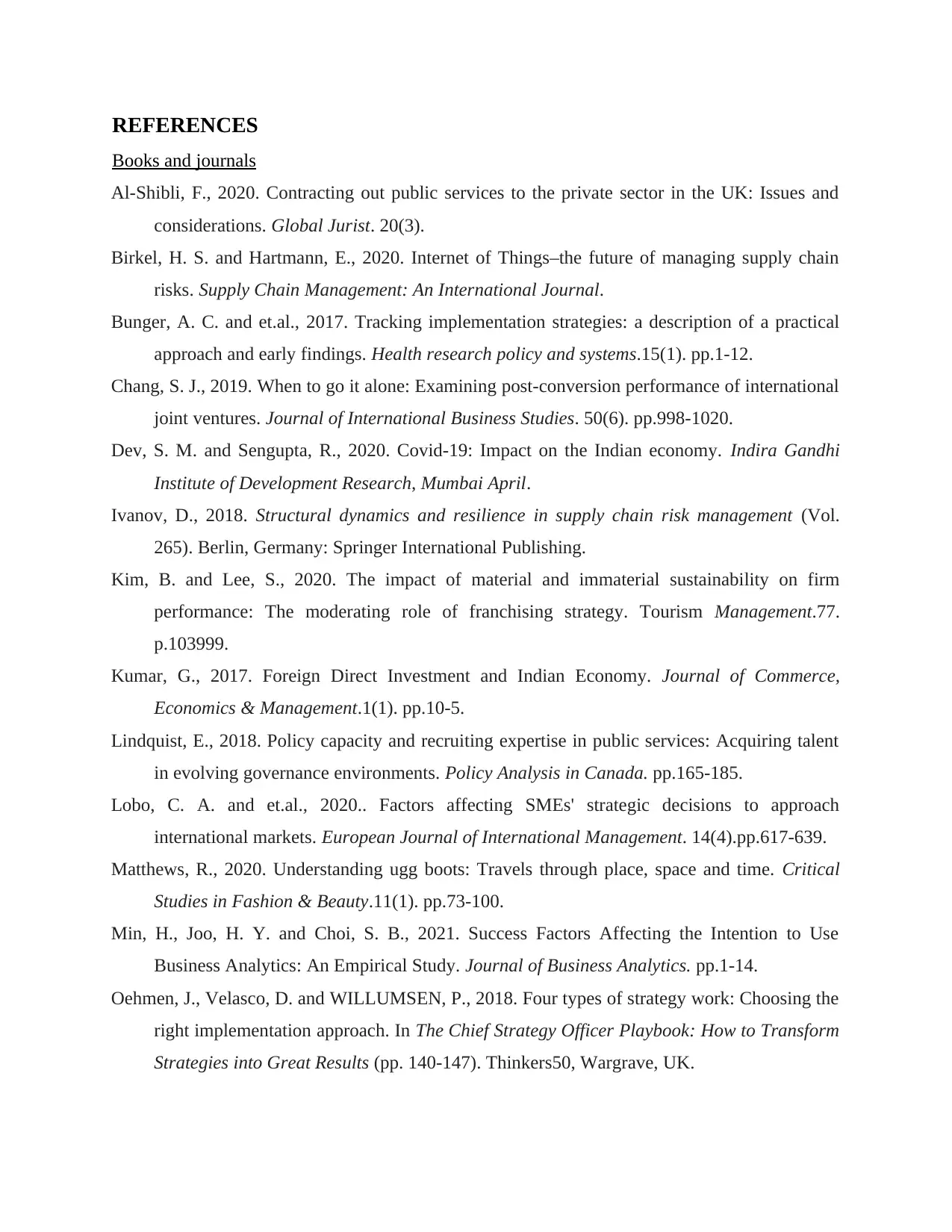
REFERENCES
Books and journals
Al-Shibli, F., 2020. Contracting out public services to the private sector in the UK: Issues and
considerations. Global Jurist. 20(3).
Birkel, H. S. and Hartmann, E., 2020. Internet of Things–the future of managing supply chain
risks. Supply Chain Management: An International Journal.
Bunger, A. C. and et.al., 2017. Tracking implementation strategies: a description of a practical
approach and early findings. Health research policy and systems.15(1). pp.1-12.
Chang, S. J., 2019. When to go it alone: Examining post-conversion performance of international
joint ventures. Journal of International Business Studies. 50(6). pp.998-1020.
Dev, S. M. and Sengupta, R., 2020. Covid-19: Impact on the Indian economy. Indira Gandhi
Institute of Development Research, Mumbai April.
Ivanov, D., 2018. Structural dynamics and resilience in supply chain risk management (Vol.
265). Berlin, Germany: Springer International Publishing.
Kim, B. and Lee, S., 2020. The impact of material and immaterial sustainability on firm
performance: The moderating role of franchising strategy. Tourism Management.77.
p.103999.
Kumar, G., 2017. Foreign Direct Investment and Indian Economy. Journal of Commerce,
Economics & Management.1(1). pp.10-5.
Lindquist, E., 2018. Policy capacity and recruiting expertise in public services: Acquiring talent
in evolving governance environments. Policy Analysis in Canada. pp.165-185.
Lobo, C. A. and et.al., 2020.. Factors affecting SMEs' strategic decisions to approach
international markets. European Journal of International Management. 14(4).pp.617-639.
Matthews, R., 2020. Understanding ugg boots: Travels through place, space and time. Critical
Studies in Fashion & Beauty.11(1). pp.73-100.
Min, H., Joo, H. Y. and Choi, S. B., 2021. Success Factors Affecting the Intention to Use
Business Analytics: An Empirical Study. Journal of Business Analytics. pp.1-14.
Oehmen, J., Velasco, D. and WILLUMSEN, P., 2018. Four types of strategy work: Choosing the
right implementation approach. In The Chief Strategy Officer Playbook: How to Transform
Strategies into Great Results (pp. 140-147). Thinkers50, Wargrave, UK.
Books and journals
Al-Shibli, F., 2020. Contracting out public services to the private sector in the UK: Issues and
considerations. Global Jurist. 20(3).
Birkel, H. S. and Hartmann, E., 2020. Internet of Things–the future of managing supply chain
risks. Supply Chain Management: An International Journal.
Bunger, A. C. and et.al., 2017. Tracking implementation strategies: a description of a practical
approach and early findings. Health research policy and systems.15(1). pp.1-12.
Chang, S. J., 2019. When to go it alone: Examining post-conversion performance of international
joint ventures. Journal of International Business Studies. 50(6). pp.998-1020.
Dev, S. M. and Sengupta, R., 2020. Covid-19: Impact on the Indian economy. Indira Gandhi
Institute of Development Research, Mumbai April.
Ivanov, D., 2018. Structural dynamics and resilience in supply chain risk management (Vol.
265). Berlin, Germany: Springer International Publishing.
Kim, B. and Lee, S., 2020. The impact of material and immaterial sustainability on firm
performance: The moderating role of franchising strategy. Tourism Management.77.
p.103999.
Kumar, G., 2017. Foreign Direct Investment and Indian Economy. Journal of Commerce,
Economics & Management.1(1). pp.10-5.
Lindquist, E., 2018. Policy capacity and recruiting expertise in public services: Acquiring talent
in evolving governance environments. Policy Analysis in Canada. pp.165-185.
Lobo, C. A. and et.al., 2020.. Factors affecting SMEs' strategic decisions to approach
international markets. European Journal of International Management. 14(4).pp.617-639.
Matthews, R., 2020. Understanding ugg boots: Travels through place, space and time. Critical
Studies in Fashion & Beauty.11(1). pp.73-100.
Min, H., Joo, H. Y. and Choi, S. B., 2021. Success Factors Affecting the Intention to Use
Business Analytics: An Empirical Study. Journal of Business Analytics. pp.1-14.
Oehmen, J., Velasco, D. and WILLUMSEN, P., 2018. Four types of strategy work: Choosing the
right implementation approach. In The Chief Strategy Officer Playbook: How to Transform
Strategies into Great Results (pp. 140-147). Thinkers50, Wargrave, UK.
Paraphrase This Document
Need a fresh take? Get an instant paraphrase of this document with our AI Paraphraser
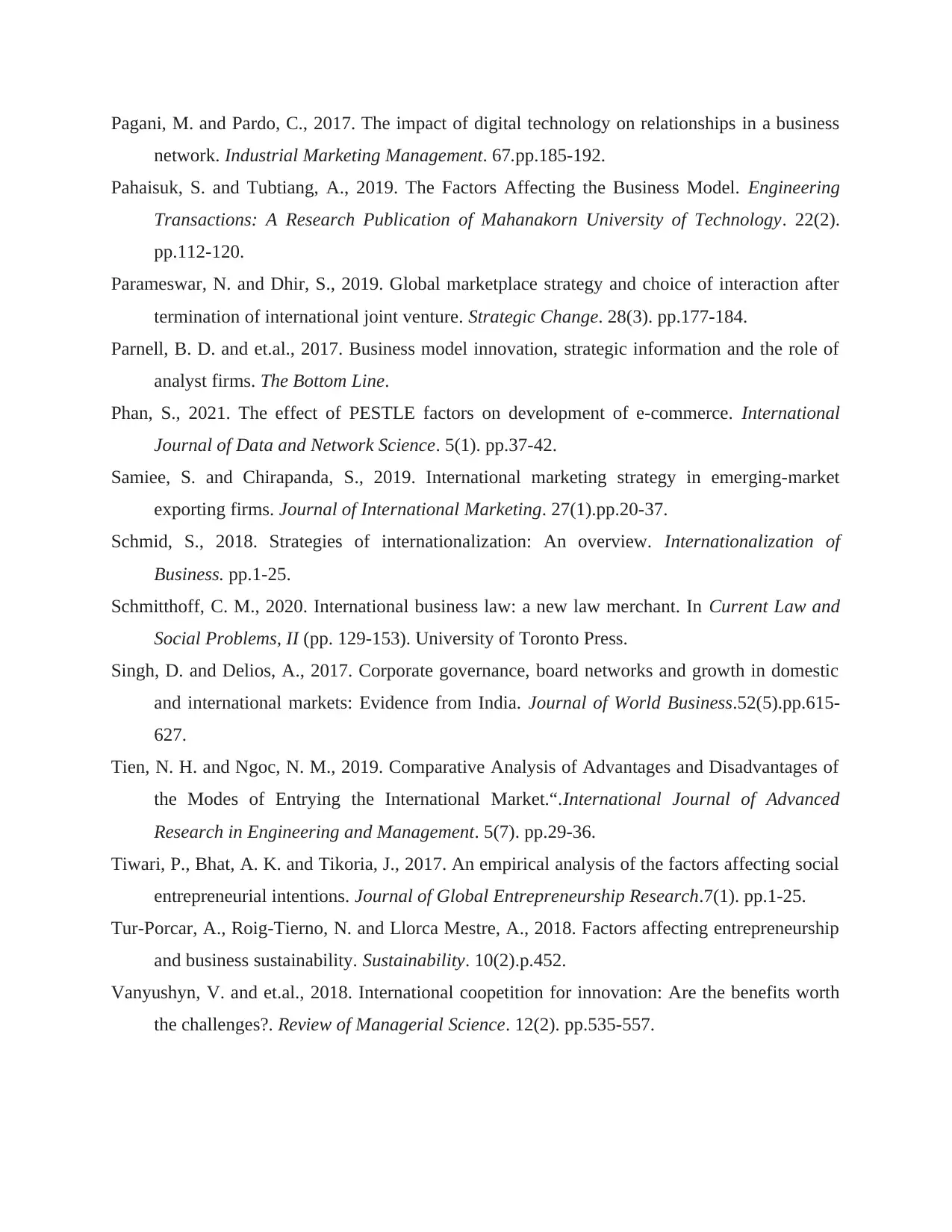
Pagani, M. and Pardo, C., 2017. The impact of digital technology on relationships in a business
network. Industrial Marketing Management. 67.pp.185-192.
Pahaisuk, S. and Tubtiang, A., 2019. The Factors Affecting the Business Model. Engineering
Transactions: A Research Publication of Mahanakorn University of Technology. 22(2).
pp.112-120.
Parameswar, N. and Dhir, S., 2019. Global marketplace strategy and choice of interaction after
termination of international joint venture. Strategic Change. 28(3). pp.177-184.
Parnell, B. D. and et.al., 2017. Business model innovation, strategic information and the role of
analyst firms. The Bottom Line.
Phan, S., 2021. The effect of PESTLE factors on development of e-commerce. International
Journal of Data and Network Science. 5(1). pp.37-42.
Samiee, S. and Chirapanda, S., 2019. International marketing strategy in emerging-market
exporting firms. Journal of International Marketing. 27(1).pp.20-37.
Schmid, S., 2018. Strategies of internationalization: An overview. Internationalization of
Business. pp.1-25.
Schmitthoff, C. M., 2020. International business law: a new law merchant. In Current Law and
Social Problems, II (pp. 129-153). University of Toronto Press.
Singh, D. and Delios, A., 2017. Corporate governance, board networks and growth in domestic
and international markets: Evidence from India. Journal of World Business.52(5).pp.615-
627.
Tien, N. H. and Ngoc, N. M., 2019. Comparative Analysis of Advantages and Disadvantages of
the Modes of Entrying the International Market.“.International Journal of Advanced
Research in Engineering and Management. 5(7). pp.29-36.
Tiwari, P., Bhat, A. K. and Tikoria, J., 2017. An empirical analysis of the factors affecting social
entrepreneurial intentions. Journal of Global Entrepreneurship Research.7(1). pp.1-25.
Tur-Porcar, A., Roig-Tierno, N. and Llorca Mestre, A., 2018. Factors affecting entrepreneurship
and business sustainability. Sustainability. 10(2).p.452.
Vanyushyn, V. and et.al., 2018. International coopetition for innovation: Are the benefits worth
the challenges?. Review of Managerial Science. 12(2). pp.535-557.
network. Industrial Marketing Management. 67.pp.185-192.
Pahaisuk, S. and Tubtiang, A., 2019. The Factors Affecting the Business Model. Engineering
Transactions: A Research Publication of Mahanakorn University of Technology. 22(2).
pp.112-120.
Parameswar, N. and Dhir, S., 2019. Global marketplace strategy and choice of interaction after
termination of international joint venture. Strategic Change. 28(3). pp.177-184.
Parnell, B. D. and et.al., 2017. Business model innovation, strategic information and the role of
analyst firms. The Bottom Line.
Phan, S., 2021. The effect of PESTLE factors on development of e-commerce. International
Journal of Data and Network Science. 5(1). pp.37-42.
Samiee, S. and Chirapanda, S., 2019. International marketing strategy in emerging-market
exporting firms. Journal of International Marketing. 27(1).pp.20-37.
Schmid, S., 2018. Strategies of internationalization: An overview. Internationalization of
Business. pp.1-25.
Schmitthoff, C. M., 2020. International business law: a new law merchant. In Current Law and
Social Problems, II (pp. 129-153). University of Toronto Press.
Singh, D. and Delios, A., 2017. Corporate governance, board networks and growth in domestic
and international markets: Evidence from India. Journal of World Business.52(5).pp.615-
627.
Tien, N. H. and Ngoc, N. M., 2019. Comparative Analysis of Advantages and Disadvantages of
the Modes of Entrying the International Market.“.International Journal of Advanced
Research in Engineering and Management. 5(7). pp.29-36.
Tiwari, P., Bhat, A. K. and Tikoria, J., 2017. An empirical analysis of the factors affecting social
entrepreneurial intentions. Journal of Global Entrepreneurship Research.7(1). pp.1-25.
Tur-Porcar, A., Roig-Tierno, N. and Llorca Mestre, A., 2018. Factors affecting entrepreneurship
and business sustainability. Sustainability. 10(2).p.452.
Vanyushyn, V. and et.al., 2018. International coopetition for innovation: Are the benefits worth
the challenges?. Review of Managerial Science. 12(2). pp.535-557.
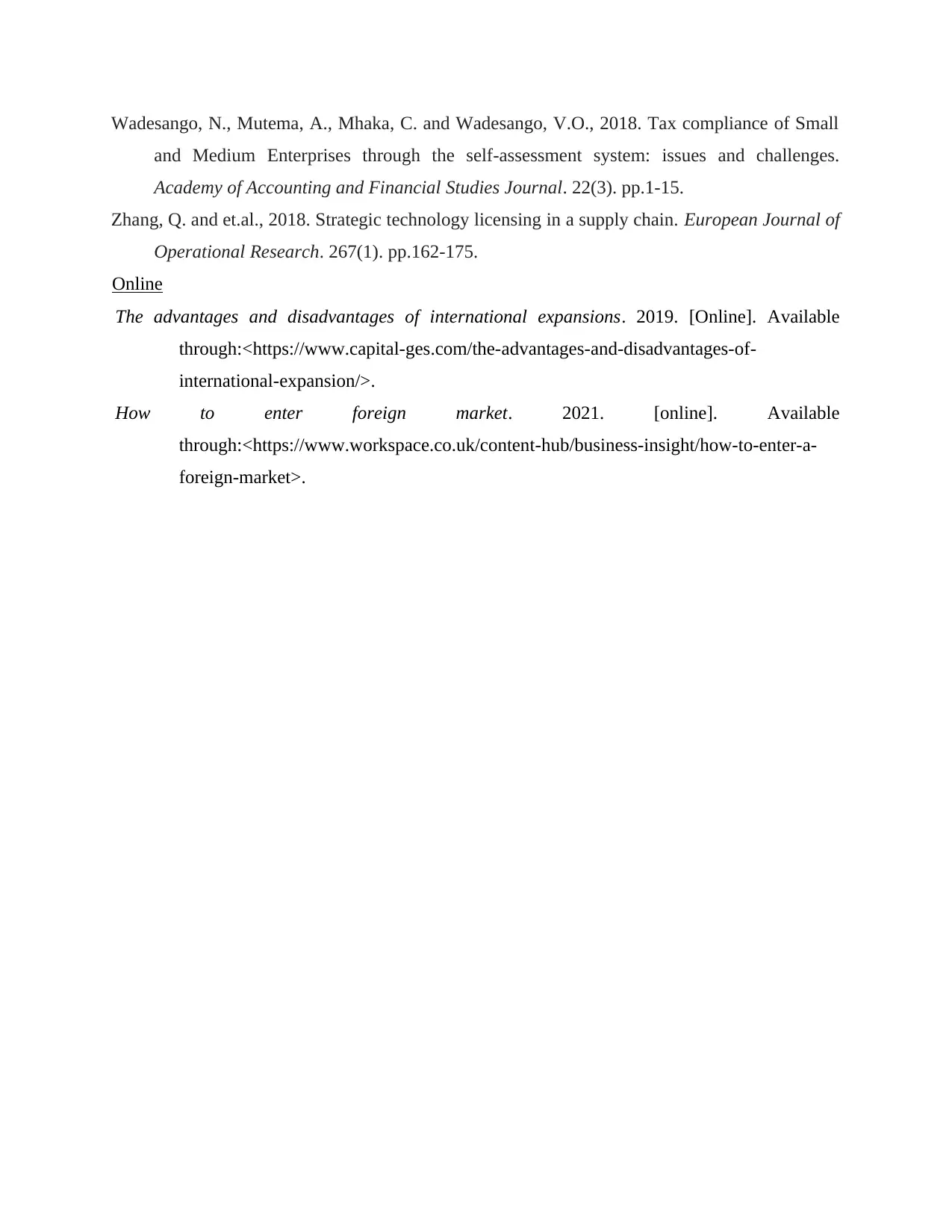
Wadesango, N., Mutema, A., Mhaka, C. and Wadesango, V.O., 2018. Tax compliance of Small
and Medium Enterprises through the self-assessment system: issues and challenges.
Academy of Accounting and Financial Studies Journal. 22(3). pp.1-15.
Zhang, Q. and et.al., 2018. Strategic technology licensing in a supply chain. European Journal of
Operational Research. 267(1). pp.162-175.
Online
The advantages and disadvantages of international expansions. 2019. [Online]. Available
through:<https://www.capital-ges.com/the-advantages-and-disadvantages-of-
international-expansion/>.
How to enter foreign market. 2021. [online]. Available
through:<https://www.workspace.co.uk/content-hub/business-insight/how-to-enter-a-
foreign-market>.
and Medium Enterprises through the self-assessment system: issues and challenges.
Academy of Accounting and Financial Studies Journal. 22(3). pp.1-15.
Zhang, Q. and et.al., 2018. Strategic technology licensing in a supply chain. European Journal of
Operational Research. 267(1). pp.162-175.
Online
The advantages and disadvantages of international expansions. 2019. [Online]. Available
through:<https://www.capital-ges.com/the-advantages-and-disadvantages-of-
international-expansion/>.
How to enter foreign market. 2021. [online]. Available
through:<https://www.workspace.co.uk/content-hub/business-insight/how-to-enter-a-
foreign-market>.
1 out of 12
![[object Object]](/_next/static/media/star-bottom.7253800d.svg)





